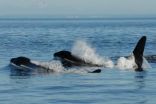(Press-News.org) BUFFALO, N.Y. -- A new Arctic study in the journal Science is helping to unravel an important mystery surrounding climate change: How quickly glaciers can melt and grow in response to shifts in temperature.
According to the new research, glaciers on Canada's Baffin Island expanded rapidly during a brief cold snap about 8,200 years ago. The discovery adds to a growing body of evidence showing that ice sheets reacted rapidly in the past to cooling or warming, raising concerns that they could do so again as the Earth heats up.
"One of the questions scientists have been asking is how long it takes for these huge chunks of ice to respond to a global climate phenomenon," said study co-author Jason Briner, PhD, a University at Buffalo associate professor of geology. "People don't know whether glaciers can respond quickly enough to matter to our grandchildren, and we're trying to answer this from a geological perspective, by looking at Earth's history."
"What we're seeing," he added, "is that these ice sheets are surprisingly sensitive to even short periods of temperature change."
Briner's colleagues on the study included lead author Nicolás Young, who worked on the study as part of his PhD at UB and is now a postdoctoral researcher at Columbia University's Lamont-Doherty Earth Observatory; Dylan H. Rood of the Scottish Universities Environmental Research Centre and the University of California, Santa Barbara; and Robert C. Finkel of UC Berkeley.
The research, scheduled to appear in Science on Sept. 14, found that mountain glaciers on Baffin Island, along with a massive North American ice sheet, expanded quickly when the Earth cooled about 8,200 years ago.
The finding was surprising because the cold snap was extremely short-lived: The temperature fell for only a few decades, and then returned to previous levels within 150 years or so.
"It's not at all amazing that a small local glacier would grow in response to an event like this, but it is incredible that a large ice sheet would do the same," Young said.
An embargoed video detailing the findings is available at http://www.youtube.com/watch?v=DZFupZp4ViI. The video and the information in this press release is embargoed until 2 p.m. U.S. Eastern Time on Thursday, Sept. 13, 2012.
To conduct the research, Briner led a team to Baffin Island to read the landscape for clues about the pre-historical size and activity of glaciers that covered the island.
Moraines -- piles of rocks and debris that glaciers deposit while expanding -- provided valuable information. By dating these and other geological features, the scientists were able to deduce that glaciers expanded rapidly on Baffin Island about 8,200 years ago, a period coinciding with a short-lived cold snap.
The researchers also found that Baffin Island's glaciers appeared to have been larger during this brief period of cooling than during the Younger Dryas period, a much more severe episode of cooling that began about 13,000 years ago and lasted more than a millennium.
This counterintuitive finding suggests that unexpected factors may govern a glacier's response to climate change.
With regard to Baffin Island, the study's authors say that while overall cooling may have been more intense during the Younger Dryas, summer temperatures may have actually decreased more during the shift 8,200 years ago. These colder summers could have fueled the glaciers' rapid advance, decreasing the length of time that ice melted during the summer.
Detailed analyses of this kind will be critical to developing accurate models for predicting how future climate change will affect glaciers around the world, Briner said.
INFORMATION:
The study was funded by the National Science Foundation.
How fast can ice sheets respond to climate change?
Scientists report that prehistoric glaciers reacted rapidly to a brief cold snap, providing a rare glimpse of glaciers' response to past climate change
2012-09-14
ELSE PRESS RELEASES FROM THIS DATE:
How early social deprivation impairs long-term cognitive function
2012-09-14
Boston, Sept. 13, 2012-- A growing body of research shows that children who suffer severe neglect and social isolation have cognitive and social impairments as adults. A study from Boston Children's Hospital shows, for the first time, how these functional impairments arise: Social isolation during early life prevents the cells that make up the brain's white matter from maturing and producing the right amount of myelin, the fatty "insulation" on nerve fibers that helps them transmit long-distance messages within the brain.
The study also identifies a molecular pathway ...
'Mini' stroke can cause major disability, may warrant clot-busters
2012-09-14
A transient ischemic attack, TIA or a "mini stroke," can lead to serious disability, but is frequently deemed by doctors too mild to treat, according to a study in the American Heart Association journal Stroke.
"Our study shows that TIA and minor stroke patients are at significant risk of disability and need early assessment and treatment," said Shelagh Coutts, M.D., lead author of the study at Foothills Hospital in Calgary, Alberta, Canada. "We should be imaging patients earlier and be more aggressive in treating patients with thrombolysis if we can see a blockage no ...
Long menopause allows killer whales to care for adult sons
2012-09-14
VIDEO:
This shows southern resident killer whales in the waters around the San Juan Islands, USA and British Columbia. Both male and female killer whales will remain with their mothers throughout...
Click here for more information.
Scientists have found the answer to why female killer whales have the longest menopause of any non-human species - to care for their adult sons. Led by the Universities of Exeter and York and published in the journal Science (14 September 2012) ...
Low cost design makes ultrasound imaging affordable to the world
2012-09-14
An ultra-low cost scanner that can be plugged into any computer or laptop to reveal vital information about the unborn child has been developed by engineers at Newcastle University, UK.
The hand-held USB device – which is roughly the size of a computer mouse – works in a similar way to existing ultrasound scanners, using pulses of high frequency sound to build up a picture of the unborn child on the computer screen.
However, unlike the technology used in most hospitals across the UK costing anywhere from £20,000-£100,000, the scanner created by Jeff Neasham and Research ...
Stress breaks loops that hold short-term memory together
2012-09-14
MADISON -- Stress has long been pegged as the enemy of attention, disrupting focus and doing substantial damage to working memory — the short-term juggling of information that allows us to do all the little things that make us productive.
By watching individual neurons at work, a group of psychologists at the University of Wisconsin–Madison has revealed just how stress can addle the mind, as well as how neurons in the brain's prefrontal cortex help "remember" information in the first place.
Working memory is short-term and flexible, allowing the brain to hold a large ...
Scripps Research scientists reveal how deadly virus silences immune system
2012-09-14
LA JOLLA, CA, September 13, 2012--Scientists at The Scripps Research Institute have determined the structure of a critical protein from the Marburg virus, a close cousin of Ebola virus. These viruses cause similar diseases and are some of the deadliest pathogens on the planet, each killing up to 90 percent of those infected.
Described in the September 13, 2012 publication of the journal PLoS Pathogens, the new research reveals how a key protein component of the Marburg virus, called VP35, blocks the human immune system, allowing the virus to grow unchecked. The structure ...
Neural implant recovers ability to make decisions
2012-09-14
Researchers have taken a key step towards recovering specific brain functions in sufferers of brain disease and injuries by successfully restoring the decision-making processes in monkeys.
By placing a neural device onto the front part of the monkeys' brains, the researchers, from Wake Forest Baptist Medical Centre, University of Kentucky and University of Southern California, were able to recover, and even improve, the monkeys' ability to make decisions when their normal cognitive functioning was disrupted.
The study, which has been published today, 14 September, in ...
Charting the SH2 pool
2012-09-14
New research published in BioMed Central's open access journal Cell Communication and Signaling describes a large set of interactions (interactome) which maps the range of phosphotyrosine (pTyr)-dependent interactions with SH2 domains underlying insulin (Ins), insulin-like growth factor-1 (IGF-1) and fibroblast growth factor (FGF) signaling pathways.
In the control of cell signaling pathways SH2 domains can be thought of as a master connector and tyrosine kinases the switch. SH2 domains interact with phosphorylated tyrosine containing peptides on receptors and other ...
Met Office model to better predict extreme winters
2012-09-14
Severe UK winters, like the 'big freeze' of 2009/10, can now be better forecast months in advance using the Met Office's latest model, new research suggests.
A new study, published today, Friday 14 September, in IOP Publishing's journal Environmental Research Letters, compares the latest seasonal forecast system to the one previously used and shows that it can better warn the UK of extreme winter weather conditions.
Dubbed the 'high-top' system, it is different from the previous system as it takes into account phenomenon known as sudden stratospheric warmings (SSWs), ...
Foraging baboons are picky punters
2012-09-14
In a study published today in The American Naturalist, a group of scientists led by the Zoological Society of London (ZSL) have used a technique developed to study human consumer choices to investigate what influences a baboon's foraging decisions. The technique, known as discrete choice modelling, has rarely been used before in animal behaviour research. It showed how baboons not only consider many social and non-social factors when making foraging decisions, but also how they change these factors depending on their habitat and their own social traits.
Over a six month ...
LAST 30 PRESS RELEASES:
KIST develops eco-friendly palladium recovery technology to safeguard resource security
Statins significantly reduce mortality risk for adults with diabetes, regardless of cardiovascular risk
Brain immune cells may drive more damage in females than males with Alzheimer’s
Evidence-based recommendations empower clinicians to manage epilepsy in pregnancy
Fungus turns bark beetles’ defenses against them
There are new antivirals being tested for herpesviruses. Scientists now know how they work
CDI scientist, colleagues author review of global burden of fungus Candida auris
How does stroke influence speech comprehension?
B cells transiently unlock their plasticity, risking lymphoma development
Advanced AI dodel predicts spoken language outcomes in deaf children after cochlear implants
Multimodal imaging-based cerebral blood flow prediction model development in simulated microgravity
Accelerated streaming subgraph matching framework is faster, more robust, and scalable
Gestational diabetes rose every year in the US since 2016
OHSU researchers find breast cancer drug boosts leukemia treatment
Fear and medical misinformation regarding risk of progression or recurrence among patients with breast cancer
Glucagonlike peptide-1 receptor agonists and asthma risk in adolescents with obesity
Reviving dormant immunity: Millimeter waves reprogram the immunosuppressive microenvironment to potentiate immunotherapy without obvious side effects
Safety decision-making for autonomous vehicles integrating passenger physiological states by fNIRS
Fires could emit more air pollution than previously estimated
A new way to map how cells choose their fate
Numbers in our sights affect how we perceive space
SIMJ announces global collaborative book project in commemoration of its 75th anniversary
Air pollution exposure and birth weight
Obstructive sleep apnea risk and mental health conditions among older adults
How talking slows eye movements behind the wheel
The Ceramic Society of Japan’s Oxoate Ceramics Research Association launches new international book project
Heart-brain connection: international study reveals the role of the vagus nerve in keeping the heart young
Researchers identify Rb1 as a predictive biomarker for a new therapeutic strategy in some breast cancers
Survey reveals ethical gaps slowing AI adoption in pediatric surgery
Stimulant ADHD medications work differently than thought
[Press-News.org] How fast can ice sheets respond to climate change?Scientists report that prehistoric glaciers reacted rapidly to a brief cold snap, providing a rare glimpse of glaciers' response to past climate change


